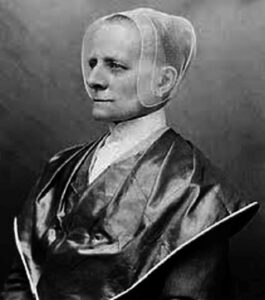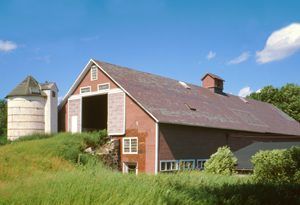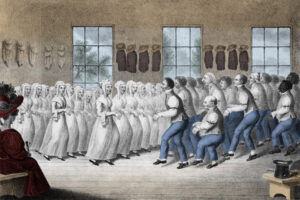The Shakers are a sect of Christianity that traces their beginnings to Manchester, England, in 1747. They called themselves The United Society of Believers in Christ’s Second Appearing. However, they became known as Shakers because they trembled, whirled, and shook during ecstatic worship services.
Ann Lee founded a significant portion of Shakerism in England in 1758 and converts believed that Christ’s second coming was realized in their leader, whom they called Mother Lee. The Shakers gathered a small group of enthusiastic followers.
Misunderstood and often persecuted in their native England, Mother Ann Lee led eight Shaker converts to North America in 1774. They left England on the ship Mariah, arriving in New York harbor, seeking the freedom to live, work, and worship according to their main religious tenets. These include celibacy, communal life, and confession of sin. They didn’t believe in procreation; therefore, they adopted children, recruited converts, and indentured children into their community. Those who were adopted were given a choice to either stay within the community or leave when they turned 21.
The Shakers also believed in racial and gender equality, simplicity, and pacifism. They were also associated with feminist and abolitionist reform movements in the 19th century. A bishop governed Shaker communities, and within the communities, individuals were grouped into “family” units and worked together to manage daily activities.
Shaker Villages:
Alfred, Maine – 1793-1931
Canterbury, New Hampshire – 1792-1992
Enfield, New Hampshire 1793-1923
Enfield, Connecticut 1792-1917
Gorham, Maine 1808-1819
Groveland, New York 1836-1892
Hancock – Pittsfield, Massachusetts 1790-1960
Harvard, Massachusetts, 1792-1918
Mount Lebanon – New Lebanon, New York – 1785-1917
Narcoosee, Florida – 1895-1924
New Canaan, Connecticut – 1810-1812
North Union – Cleveland, Ohio – 1822-1899
Philadelphia, Pennsylvania 1858-c.1910
Pleasant Hill, Harrodsburg, Kentucky 1806-1910
Sabbathday, New Gloucester, Maine, 1794-present
Savoy, Massachusetts – 1817-1821
Shirley, Massachusetts – 1793-1908
Sodus Bay – Huron New York 1826-1836
South Union, Kentucky 1807-1922
Tyringham, Massachusetts – 1792-1875
Union Village – Turtlecreek Township, Ohio – 1805-1912
Watervliet – Albany, New York – 1776-1926
Watervliet – Kettering, Ohio – 1806-1900
West Union – Busro, Indiana – 1807-1827
White Oak, Georgia – 1898-1902
Whitewater – New Haven, Ohio – 1822-1916
The converts soon purchased land near Watervliet, New York, a frontier wilderness northwest of Albany, where they settled. Mother Ann soon embarked on a series of missionary journeys throughout New York and New England, gathering many converts to the new Christian movement.
Mother Ann passed away in 1784, and various leaders followed. In the subsequent decades, the converts and leaders worked to expand the network of communal villages. The first settlements were organized in upstate New York and New England. Later, Shaker communities appeared in the Midwestern states through Shaker missionary efforts.
By 1836, 18 major, long-term societies were founded, comprising about 60 families and a failed commune in Indiana. Many smaller, short-lived communities were established over the 19th century, including two failed ventures into the Southeastern United States and an urban community in Philadelphia, Pennsylvania. They referred to those who lived outside their communities as people from “the World.”
Communities were agriculturally based, and men and women lived, and mostly worked, apart. They were also known for their manufactured goods, inventing metal pen nibs, the flat broom, a prototype washing machine called a wash mill, the circular saw the waterproof and wrinkle-free cloth, and improved the plow.
The community meeting house was the center of Shaker worship services on Sunday. Services included singing hymns, spontaneous dancing, testimonials, a short sermon, and silence.
The Shakers peaked in population by the 1840s and early 1850s, with a membership between 4,000 and 9,000. Membership growth began to stagnate by the mid-1850s.
By the time the Civil War began, 6,000 shakers had maintained economic autonomy while making items for outside commercial distribution. Their agrarian work was eventually redirected to handicrafts, particularly furniture. After the war and subsequent Industrial Revolution, Shakerism went into severe decline. The newly industrialized economy made it difficult for them to compete, and waning prosperity made it difficult to recruit converts. As the number of living Shakers diminished, Shaker communities were disbanded.
Some of their buildings and sites have become museums, and many are historic districts listed on the National Register of Historic Places. The only active community is Sabbathday Lake Shaker Village in Maine, which has at least three active members.
The Shakers are one of American history’s most intriguing social and religious movements. They are also one of the longest-lived and are considered by many to be the most successful of the hundreds of communal groups and utopian societies in this country.
© Kathy Alexander/Legends of America, updated February 2024.
Also See:
Immigration to the United States
Sources:
Hancock Shaker Village
National Park Service – 1
National Park Service – 2
Wikipedia




